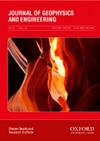Fitness landscape analysis for seismic history matching problems of subsurface reservoirs
IF 1.7
3区 地球科学
Q3 GEOCHEMISTRY & GEOPHYSICS
引用次数: 0
Abstract
Abstract Despite over twenty years of research, assisted seismic history matching (ASHM) remains a challenging problem for the energy industry. ASHM is an optimisation problem to find the best subsurface reservoir model for robust predictions of field performance. The results are typically assessed by a decreasing misfit between simulated and observed data, but the optimised models are often inaccurate, uncertain, and non-unique. In this paper, we take a fresh look at ASHM and view it from the perspective of the fitness landscape, or search space. We propose that characterising the fitness landscape will lead to a deeper understanding of the problem, greater confidence in the optimised models, and a better appreciation of the uncertainties. Fitness landscape analysis (FLA) is established in other fields, but has mostly been applied to combinatorial problems or continuous problems with analytical solutions. In contrast, ASHM is a real-world, ill-posed, inverse problem, which is computationally expensive and contains data errors and model uncertainties. We introduce a new method for FLA that provides intuitive information on the setup of the problem. It uses multidimensional clustering and visualisation to explore the structure of the landscape and detects the presence and relative magnitude of data errors, which are typical of real data. It is applied to a synthetic, full-field, reservoir model and the results are compared with another more-established method. We found that the fitness landscapes of ASHM problems are low-lying plateaus with many minima, which makes it difficult to solve ASHM problems for real-world datasets.地下储层地震史匹配问题的适合度景观分析
尽管进行了20多年的研究,但对于能源行业来说,辅助地震历史匹配(ASHM)仍然是一个具有挑战性的问题。ASHM是一个优化问题,旨在找到最佳的地下油藏模型,以实现对油田动态的稳健预测。结果通常是通过模拟数据和观测数据之间的不拟合减小来评估的,但是优化的模型通常是不准确的、不确定的和非唯一的。在本文中,我们重新审视ASHM,并从健身景观或搜索空间的角度来看待它。我们提出,刻画健身景观将导致对问题的更深入理解,对优化模型的更大信心,以及对不确定性的更好理解。适应度景观分析(FLA)在其他领域也有建立,但大多应用于组合问题或具有解析解的连续问题。相反,ASHM是一个现实世界的、不适定的逆问题,它的计算成本很高,并且包含数据误差和模型不确定性。我们介绍了一种新的FLA方法,它提供了关于问题设置的直观信息。它使用多维聚类和可视化来探索景观的结构,并检测数据错误的存在和相对大小,这是真实数据的典型特征。将其应用于一个综合的全油田油藏模型,并与另一种更成熟的方法进行了比较。我们发现,ASHM问题的适应度景观是具有许多最小值的低洼高原,这使得解决现实数据集的ASHM问题变得困难。
本文章由计算机程序翻译,如有差异,请以英文原文为准。
求助全文
约1分钟内获得全文
求助全文
来源期刊

Journal of Geophysics and Engineering
工程技术-地球化学与地球物理
CiteScore
2.50
自引率
21.40%
发文量
87
审稿时长
4 months
期刊介绍:
Journal of Geophysics and Engineering aims to promote research and developments in geophysics and related areas of engineering. It has a predominantly applied science and engineering focus, but solicits and accepts high-quality contributions in all earth-physics disciplines, including geodynamics, natural and controlled-source seismology, oil, gas and mineral exploration, petrophysics and reservoir geophysics. The journal covers those aspects of engineering that are closely related to geophysics, or on the targets and problems that geophysics addresses. Typically, this is engineering focused on the subsurface, particularly petroleum engineering, rock mechanics, geophysical software engineering, drilling technology, remote sensing, instrumentation and sensor design.
 求助内容:
求助内容: 应助结果提醒方式:
应助结果提醒方式:


